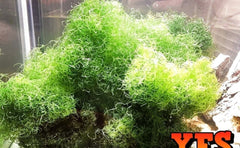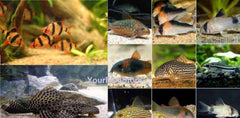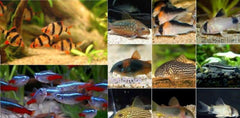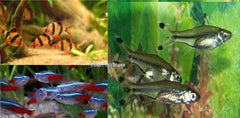x2 Package - Apistogramma Rubrolineata Cichlid Sml 1"- 1 1/2" Each
Ebay

This Package Includes x2 Fish.
Temperature: 70 to 85F
pH: 6 to 6.5
Region:
The distribution range of A. baenschi is only fragmentarily known, for it is a relatively new species first collected by Japanese aquarists as late as 2002. This dwarf cichlid inhabits (although not exclusively) the Huallaga drainage basin in northwestern Peru, and specifically rivers in the vicinity of Yurimagas: Rio Hanusi, Rio Paranapura and the Rio Huallaga itself. In its natural environment, the species lives in acidic water with a pH of 4.1 to 6.3. Apistogramma bitaeniata is most often found in the upper and middle reaches of the rivers Amazon, Ucayali and Napo; it also inhabits the Amazon lowlands in Brazil, in the Tefe region. There are many color varieties of the species: yellow, blue, red and many intermediate ones. The appropriate pH for A. bitaeniata is around 6 to 6.5.
Care:
The dwarf cichlids I kept were wild-caught (FO), and it was difficult at first to accustom them to captive foods. For this reason, I gave them frozen larvae of Culex, Chaoborus and Daphnia, as well as adult Artemia and finely ground shrimp. Food containing ballast substances (chitin or cellulose) should predominate in their diet. These ingredients are necessary for proper nutrition:they prevent constipation and promote better absorption of various nutrients. Among these foods are spinach (cellulose), Daphnia and shrimp (chitin).
Reproduction:
Unfortunately, these species are not long-lived (like the majority of the Apistogramma). Their life spans — depending on the conditions in which they are kept — range from one to two years (there are always exceptions). Their reproductive ability develops relatively early for cichlids (at 4 to 5 months of age), but it also declines rapidly.
Food:
Apistogramma baenschi especially likes to dig in search of food, so use a sand substrate. There should be many hiding places in the aquarium, where the females can find shelter and where spawning may occur. For these reasons, include pieces of petrified wood and driftwood, as well as coconut shells. Dwarf cichlids look their best against a background of lush greenery, so add some plants, such as Java moss (Vesicularia dubyana) and Amazon swords (Echinodorus spp.)
Apistogramma are sensitive to poor water quality, which can lead to skin and fin disease, most often ulcers and fungal infections. These species do not tolerate malachite green, so if necessary, use some other medication. Monitor water quality and do weekly water changes of 40 to 60 percent. Even slightly elevated levels of nitrogen compounds usually cause these fish to become listless, timid and faded.
Add Your Freebie
Orders Over $149
Freebies ~ Click Below
___________
Cichlid Compatibility Chart ~ Click Here
About Us: YourFishStore takes great pride and care in all livestock shipped out. We specialize in providing top quality cichlids and rare tropical fish to hobbyist across the country. We quarantine & treat all newly arrived fish and each fish is thoroughly inspected and spot fed to ensure they are actively eating and disease free.
*Additionally, Everything on our website is FREE Shipping with NO Minimum. Enjoy and browse through 1000's of our specialized packages.
Shipping Method: All Fish Packages qualify for FREE Shipping with NO Minimum. FedEx Priority Overnight AM. We ship out all orders On Wednesday For Thursday Arrival.
Care and Packaging: Our primary concern is the health and safety of your fish. To achieve this standard, we professionally package all aquatic life in the best materials and use the most direct and reliable shipping method which is FedEx Priority Overnight AM.
Fish come from distributors who have already acclimated the fish to aquarium conditions after arrival from around the world. Fish are then hand-picked and prepared for shipment to you. Fish are packaged in properly conditioned saltwater with correct pH levels in heavy-duty poly bags to cushion and protect. Each bag is filled with oxygen for optimal conditions and secured by a professional bag sealing technology. The water and airtight bags are then housed in Styrofoam coolers along with a heat or ice pack, as seasonal conditions dictate.
QUESTIONS & ANSWERS
Have a Question?
Be the first to ask a question about this.















